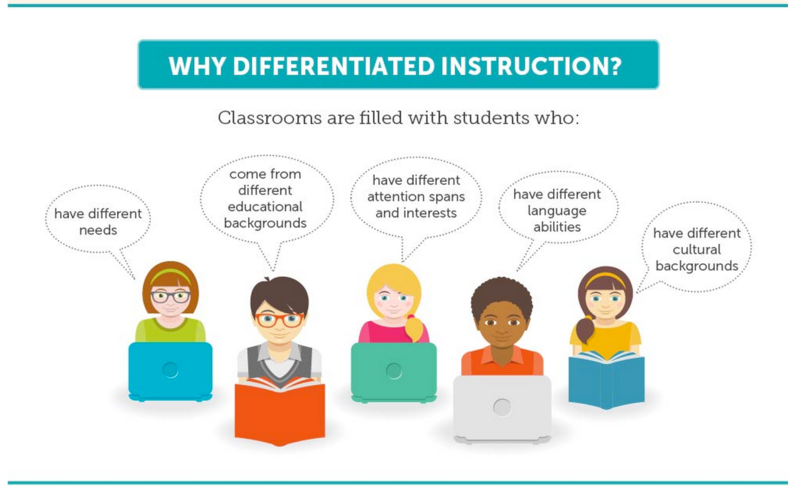e-Learning Ecologies MOOC’s Updates
Software for differentiated instruction and its' many examples
In this course we have seen that technology itself isn't enough to improve education, since it has a neutral force unless we actually use them in truly innovative ways. One such case has been software for differentiated instruction. Differentiated instruction is adapting the class course to the students in order to allow them to thrive, therefore recognizing that each students is a unique person with different needs. This can be content differentiation, learning environment differentiation, assessment and feedback differentiation. It’s an old idea that has always been terribly impractical for the teacher since it involved a lot of time and work.
The reasons for differentiated instruction can be summarized in the image below:
However now we can see it become a reality with different technologies available.
In terms of content differentiation there is a great example called Building Blocks. This is K-8program with thousands of animated activities that uses personalized lessons and learning paths to improve student’s math skills. This means not everyone has to be on the same page or at the same skill level at the same time. Students can develop their skills at their own pace without having to compare each to each other.
The demostration of the software can be seen here: https://www.youtube.com/watch?v=L007tB7EzVQ
For learning environment differentiation we see a lot of softwares that attempt to facilitate classroom participation in a way that deviates from the classic raise-your-hand-and-wait-for-teacher while also allowing the teacher to control the classroom environment. One clear example is Pear Deck, which lets teachers create quizzes, slides, or presentations, once the decks are created, students can respond via their mobile devices. This means the students get to be more engaged with the lessons while also making it manageable for the teacher.
They way it works can be seen here: https://www.youtube.com/watch?v=evoJy4WcReM
At last we have assessment and feedback differentiation. This is probably one of the most practical aspects of software for differentiated assessment as it allows the teacher to consider the individualities of the students without being swamped with work. An example of this is Answer Pad, which allows the classroom to go paperless along real time assessment and collaboration. At the same time it collects the data to build reports that allow for more precise feedback.
An overview of the program can be seen here: https://www.youtube.com/watch?v=gIdVVnDXbC8
We can see that this kind of software allows for differentiated assessment to be an integral part of learning. It also matches the classroom with reality. Technology has become more important in society and it plays an important part in people’s everyday lives. Asking for technology to be left outside of the classroom makes the students less focused and separates teaching from their reality. Therefore using technology to differentiate learning also allows for it to feel more connected to what students are used to in their lives and makes them more interested in learning.
Sources:
Barkhurst, B., Brush, J., Szeto, H., & Wong, C. (n.d.). Social Approaches to Learning. Retrieved April 11, 2020, from https://blogs.ubc.ca/socialapproaches/situated-cognition-part-2/
Jimenez, D., 2020. Steps For Teachers & Site Leaders To Apply Differentiated Instruction - Illuminate Education. [online] Illuminate Education. Available at: <https://www.illuminateed.com/blog/2017/07/steps-teachers-site-leaders-apply-differentiated-instruction/> [Accessed 16 April 2020].
Carolan, J., 2020. How Software Can Make A Differentiated Difference - Edsurge News. [online] EdSurge. Available at: <https://www.edsurge.com/news/2014-09-16-opinion-how-software-can-make-a-differentiated-difference> [Accessed 16 April 2020].
Carolan, J., 2020. How Software Can Make A Differentiated Difference - Edsurge News. [online] EdSurge. Available at: <https://www.edsurge.com/news/2014-09-16-opinion-how-software-can-make-a-differentiated-difference> [Accessed 16 April 2020].



@Teresa Bretón Orrala, thank you for the useful links.
I, like you understand the argument for personalized programmes which these software packages provide. I think current classrooms remain 'one-size fits all' to a greater extent, despite the best efforts of most teachers. The immediate feedback which diagnoses and sets individualized pathways is such a powerful tool too.
The advantages are clear. Have you found any disadvantages that are important?